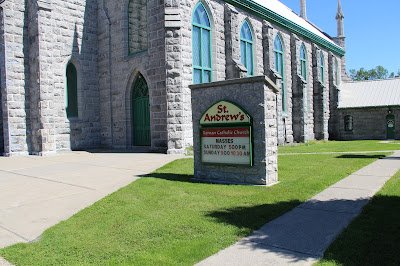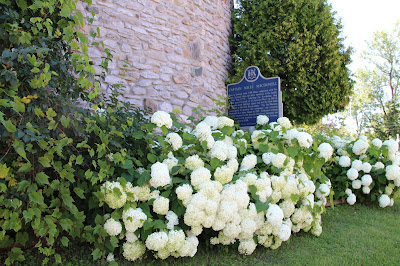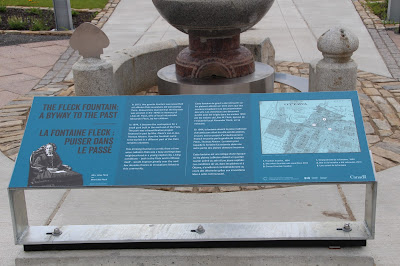Many memorials, especially plaques located in the places they commemorate, get few visitors. The cairn that commemorates Holstein Friesian Cattle in Ontario, likely gets fewer visitors than most. To get to this memorial, travel east of Upper Canada Village on County Road 2, turn right, headed to the Upper Canada Bird Sanctuary, on Aultsville Road on which the speed limit is 25 kph on a narrow gravel road. Bear left on Morrisons Road and look to the left (north side) for the cairn.
HOLSTEIN FRIESIAN CATTLE IN ONTARIO
In 1881 Michael Cook, who operated a prosperous 200-acre farm here, imported the first Holtein Friesian cattle into Ontario. This was part of a movement among progressive farmers to find a breed of cattle that would produce enough milk for Ontario's growing dairy industry, especially cheese production. Initially Cook imported two bulls and ten cows. He continued to import Holstein cattle from the United States and The Netherlands, and distribute them throughout the province. The Holstein quickly established its reputation with Ontario farmers and, in 1886, the Dairymen's Association of Eastern Ontario recognized the Holstein as the leading milk producing breed.
Ontario Heritage Foundation, an agency of the Government of Ontario
LES BOVINS HOLSTEIN-FRIESIAN EN ONTARIO
En 1881, Michael Cook, agriculteur prospère établi ici sur 200 acres, importe en Ontario les premier bovins Holstein - Friesian. Cette initiative, inscrite dans le mouvement des agriculteurs progressistes, vise à sélectionner une race bovine axée sur la sur la production laitière afin de satisfaire les besoins d'une industrie laitière ontarienne en pleine croissance, avec notamment la fabriction de fromages. cook commence par importer deux taureaux et dix vaches et continue à en faire venir des Etats-Unis et des Pays-Bas, qu'il disperse dans toute la province. Les Holstein établissent rapidement leur réputation auprès des agriculteurs onatariens et, en 1886, la Dairymen's Association of Eastern Ontario reconnaît cette race comme l'une des meilleures pour la performance laitière.
Fondation du patrimoine ontarien, un organisme du gouvernement de l'Ontario
HOLSTEIN CENTENNIAL
1881 - 1981
COMMEMORATING 100 YEARS OF HOLSTEIN BREEDING IN CANADA.
MICHAEL P. COOK WAS THE FIRST IMPORTER OF HOLSTEIN FRIESIAN CATTLE INTO ONTARIO IN 1881.
FIRST IMPORTATION: 2 BULLS 10 COWS TO AULTSVILLE, ONTARIO, STORMONT COUNTY.
CATTLE FROM THIS SHIPMENT FOUNDED THE BASE OF THE HOLSTEIN BREED TODAY.
HOLSTEINS THE MOST POPULAR DAIRY BREED.
MICHAEL P. COOK WAS THE FIRST PRESIDENT ELECTED BY THE HOLSTEIN-FRIESIAN ASSOCIATION OF CANADA.
CANADIAN MEMBERSHIP 14,000 IN 1981.
125,000 REGISTRATIONS IN 1980.
PRESENTED BY ONTARIO BRANCH OF THE HOLSTEIN-FRIESIAN ASSOCIATION OF CANADA AND STORMONT COUNTY HOLSTEIN CLUB

Monday, January 29, 2018
Thursday, January 25, 2018
Simon Fraser Plaque
West of St. Andrews West, on the southeast corner of County Road 18 and Valade Road stands a plaque commemorating Simon Fraser.
SIMON FRASER 1776-1862
This famout fur trader and explorer, son of a Loyalist officer, was born in what is now Vermont and came to Canada in 1784. He entered the fur trade with teh North West Company in 1792 and in 1805 was placed in charge of operations west of the Rocky Mountains. In 1808, while searching for a water route to the Pacific, Fraser descended to the turbulent river which bears his name. The skill and daring required to traverse thos 500 miles with their violent whirlpools and rapids make this feat one of the most outstanding in the exploration of Canada. Retiring from the Company in 1817, he settled on this property where he farmed and operated mills.
Erected by the Arhaeological and Historic Sits Board, Department of Public Records and Archives of Ontario
SIMON FRASER 1776-1862
This famout fur trader and explorer, son of a Loyalist officer, was born in what is now Vermont and came to Canada in 1784. He entered the fur trade with teh North West Company in 1792 and in 1805 was placed in charge of operations west of the Rocky Mountains. In 1808, while searching for a water route to the Pacific, Fraser descended to the turbulent river which bears his name. The skill and daring required to traverse thos 500 miles with their violent whirlpools and rapids make this feat one of the most outstanding in the exploration of Canada. Retiring from the Company in 1817, he settled on this property where he farmed and operated mills.
Erected by the Arhaeological and Historic Sits Board, Department of Public Records and Archives of Ontario
Monday, January 22, 2018
St. Andrew's Church
St. Andrew's Church occupies the southwest corner of County Road 18 and St. Andrews Road, in Saint Andrews West, Ontario.
ST. ANDREW'S CHURCH
This building, the oldest remaining stone structure in teh province erected as a church, was completed about 1801. Many of the pioneer settlers in this area were Roman Catholic Highlanders, ministered to by the Rev. Roderick Macdonell, the missionary at St. Regis. The church was built under his leadership, with the assistance of a prominent local settler, "Spanish" John Macdonell, who obtained contributions for its construction from members of the North West Company and other fur traders. It was used as a hospital during the War of 1812, ans served its congregation until replaced by the adjacent church in 1860. Simon Fraser and Sandfield Macdonald are bried in the graveyard opposite.
Arhaeological and Historic Sites Board of Ontario.
ST. ANDREW'S CHURCH
This building, the oldest remaining stone structure in teh province erected as a church, was completed about 1801. Many of the pioneer settlers in this area were Roman Catholic Highlanders, ministered to by the Rev. Roderick Macdonell, the missionary at St. Regis. The church was built under his leadership, with the assistance of a prominent local settler, "Spanish" John Macdonell, who obtained contributions for its construction from members of the North West Company and other fur traders. It was used as a hospital during the War of 1812, ans served its congregation until replaced by the adjacent church in 1860. Simon Fraser and Sandfield Macdonald are bried in the graveyard opposite.
Arhaeological and Historic Sites Board of Ontario.
Thursday, January 18, 2018
Captain Miles Macdonell Plaque
In St. Andrews West, Ontario, north of Cornwall, on the southwest corner of County Road 18 and St. Andrews Road beside St. Andrew's church stands a plaque commemorating Captain Miles Macdonell.
CAPTAIN MILES MACDONELL
Born in Scotland about 1769, Miles emigrated with his father 'Spanish' John, and other members of the family to New York, 1773. Following the Revolution, they settled near Cornwall at St. Andrews West. In 1811-12 he became Lord Selkirk's agent, and led the first band of settlers to the Red River colony. The Nor'Westers endeavoured to destroy the settlement, and arrested Macdonell on a false charge in 1815. Released without trial, he returned to his farm in Osnabruck township, but later moved to his brother's residence at Point Fortune, where he died in 1828.
Erected by the Ontario Archaeological and Historic Sites Board.
CAPTAIN MILES MACDONELL
Born in Scotland about 1769, Miles emigrated with his father 'Spanish' John, and other members of the family to New York, 1773. Following the Revolution, they settled near Cornwall at St. Andrews West. In 1811-12 he became Lord Selkirk's agent, and led the first band of settlers to the Red River colony. The Nor'Westers endeavoured to destroy the settlement, and arrested Macdonell on a false charge in 1815. Released without trial, he returned to his farm in Osnabruck township, but later moved to his brother's residence at Point Fortune, where he died in 1828.
Erected by the Ontario Archaeological and Historic Sites Board.
Monday, January 15, 2018
Fleck Fountain
The Fleck Fountain occupies a place on the southwest corner of Sir John A. Macdonald Parkway and Booth Street in Ottawa, Ontario.
The site accompanying the fountain acts like a small museum with historical information and pictures of Ottawa. You'll find visiting it worth your time.
THE FLECK FOUNTAIN: A BYWAY TO THE PAST
In 2013, this granite fountain was unearthed at LeBreton Flats as workers did soil cleanup there. Researchers learned that the fountain was erected in the 1890s in memory of Lilias W. Fleck, wife of local industrialist Alexander Fleck, by her children.
In 1894, it became the centrepiece for a small park built in the east end of the Flats. The park was a beautification project financed in part by Mrs. Fleck's son-in-law, Thomas Ahearn. How the fountain came to be buried in a different part of the Flats remains unknown.
The drinking fountain is a relic from a time when LeBreton Flats was a busy working-class neighbourhood in a young capital city. Living conditions - both in the Flats and in Ottawa itself - would improve greatly over the next few decades thanks to innovations linked to this community.
LA FONTAINE FLECK : PUISER DANS LE PASSÉ
Cette fontaine de granit a été retrouvée sur les plaines Le Breton en 2013 alors que des ouvriers travaillaient à la décontamination des sols. Les chercheiurs ont découvert qu'elle avait été érigée dans les années 1890 par les enfants de Lilias W. Fleck, épouse de l'industriel local Alexander Fleck, en sa mémoire.
En 1894, la fontaine devient la pièce maîtresse d'un petit parc situé du côté est des plaines. Le parc est un projét d'embellissement financé en partie par le gendre de madame Fleck, Thomas Ahearn. La raison pour laquelle la fontaine fut enterrée dans une autre partie des plaines demeure inconnue.
Cette fontaine est une relique d'une époque où les plaines LeBreton étaient un quartier ouvrier animé au sein d'une jeune capitale. Les conditions de vie, dans les plaines et à Ottawa, s'améliorent considérablement au cours des décennies grâce aux innovations liées à cette communauté.
1. Fountain location, 1894
2. Site where fountain was unearthed, 2013
3. Current fountain location
1. Emplacement de la fontaine, 1894
2. Site où la fontaine a été retrouvée, 2013
3. Lieu actuel de la fontaine
The Fleck Fountain is an example of a Victorian-era drinking fountain. Like the one in this photo, it provided fresh water for people and animals.
—
La fontaine Fleck est un example d'une fontaine d'eau potable de l'époque victorienne. Comme la fontaine sur cette photo, elle fournit de l'eau fraîche pour les gens et les animaux.
The site accompanying the fountain acts like a small museum with historical information and pictures of Ottawa. You'll find visiting it worth your time.
THE FLECK FOUNTAIN: A BYWAY TO THE PAST
In 2013, this granite fountain was unearthed at LeBreton Flats as workers did soil cleanup there. Researchers learned that the fountain was erected in the 1890s in memory of Lilias W. Fleck, wife of local industrialist Alexander Fleck, by her children.
In 1894, it became the centrepiece for a small park built in the east end of the Flats. The park was a beautification project financed in part by Mrs. Fleck's son-in-law, Thomas Ahearn. How the fountain came to be buried in a different part of the Flats remains unknown.
The drinking fountain is a relic from a time when LeBreton Flats was a busy working-class neighbourhood in a young capital city. Living conditions - both in the Flats and in Ottawa itself - would improve greatly over the next few decades thanks to innovations linked to this community.
LA FONTAINE FLECK : PUISER DANS LE PASSÉ
Cette fontaine de granit a été retrouvée sur les plaines Le Breton en 2013 alors que des ouvriers travaillaient à la décontamination des sols. Les chercheiurs ont découvert qu'elle avait été érigée dans les années 1890 par les enfants de Lilias W. Fleck, épouse de l'industriel local Alexander Fleck, en sa mémoire.
En 1894, la fontaine devient la pièce maîtresse d'un petit parc situé du côté est des plaines. Le parc est un projét d'embellissement financé en partie par le gendre de madame Fleck, Thomas Ahearn. La raison pour laquelle la fontaine fut enterrée dans une autre partie des plaines demeure inconnue.
Cette fontaine est une relique d'une époque où les plaines LeBreton étaient un quartier ouvrier animé au sein d'une jeune capitale. Les conditions de vie, dans les plaines et à Ottawa, s'améliorent considérablement au cours des décennies grâce aux innovations liées à cette communauté.
1. Fountain location, 1894
2. Site where fountain was unearthed, 2013
3. Current fountain location
1. Emplacement de la fontaine, 1894
2. Site où la fontaine a été retrouvée, 2013
3. Lieu actuel de la fontaine
The Fleck Fountain is an example of a Victorian-era drinking fountain. Like the one in this photo, it provided fresh water for people and animals.
—
La fontaine Fleck est un example d'une fontaine d'eau potable de l'époque victorienne. Comme la fontaine sur cette photo, elle fournit de l'eau fraîche pour les gens et les animaux.
 |
| IN LOVING MEMORY OF ♦ LILIAS W. FLECK ♦ ERECTED BY HER CHILDREN |
 |
| Note that stainless steel structures stand in for the missing parts of the fountain. |
 |
| A map with streets and their names were engraved in the concrete here. |
Subscribe to:
Comments (Atom)






























































